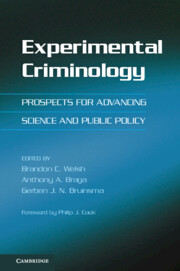11 results
Part II - Experimenting with Crime Prevention and Criminal Justice
-
- Book:
- Experimental Criminology
- Published online:
- 05 June 2014
- Print publication:
- 09 September 2013, pp 109-110
-
- Chapter
- Export citation
Preface
-
- Book:
- Experimental Criminology
- Published online:
- 05 June 2014
- Print publication:
- 09 September 2013, pp xiii-xiv
-
- Chapter
- Export citation
12 - Integrating Experimental and Observational Methods to Improve Criminology and Criminal Justice Policy
-
-
- Book:
- Experimental Criminology
- Published online:
- 05 June 2014
- Print publication:
- 09 September 2013, pp 277-298
-
- Chapter
- Export citation
1 - Experimenting with Crime and Criminal Justice
-
-
- Book:
- Experimental Criminology
- Published online:
- 05 June 2014
- Print publication:
- 09 September 2013, pp 1-12
-
- Chapter
- Export citation
Contents
-
- Book:
- Experimental Criminology
- Published online:
- 05 June 2014
- Print publication:
- 09 September 2013, pp v-vi
-
- Chapter
- Export citation
Part III - Assessing Research Evidence and Future Directions
-
- Book:
- Experimental Criminology
- Published online:
- 05 June 2014
- Print publication:
- 09 September 2013, pp 251-252
-
- Chapter
- Export citation
Part I - Experimenting with Crime
-
- Book:
- Experimental Criminology
- Published online:
- 05 June 2014
- Print publication:
- 09 September 2013, pp 13-14
-
- Chapter
- Export citation
Index
-
- Book:
- Experimental Criminology
- Published online:
- 05 June 2014
- Print publication:
- 09 September 2013, pp 299-309
-
- Chapter
- Export citation

Experimental Criminology
- Prospects for Advancing Science and Public Policy
-
- Published online:
- 05 June 2014
- Print publication:
- 09 September 2013
Contributors
-
- Book:
- Experimental Criminology
- Published online:
- 05 June 2014
- Print publication:
- 09 September 2013, pp vii-viii
-
- Chapter
- Export citation
Frontmatter
-
- Book:
- Experimental Criminology
- Published online:
- 05 June 2014
- Print publication:
- 09 September 2013, pp i-iv
-
- Chapter
- Export citation



